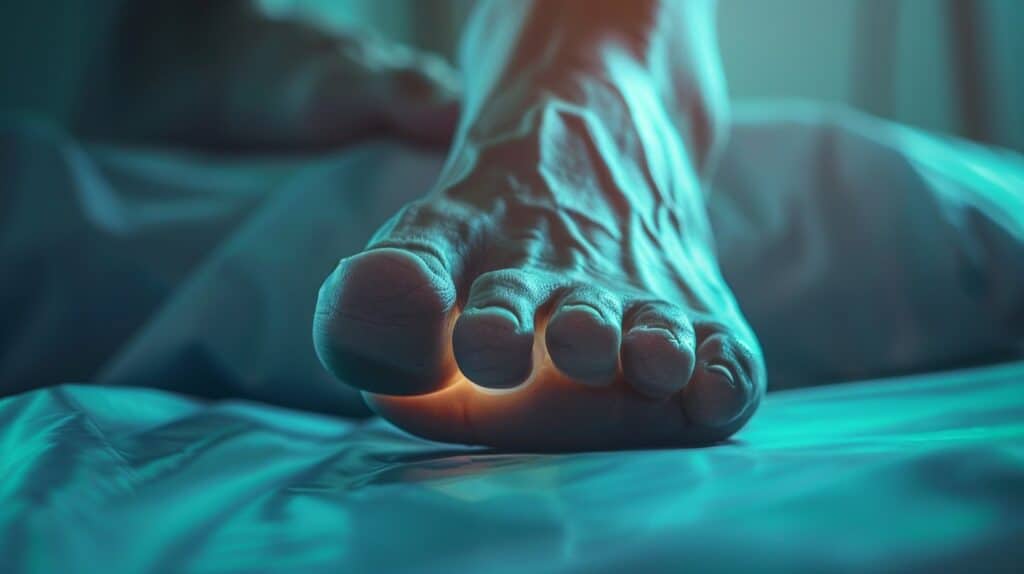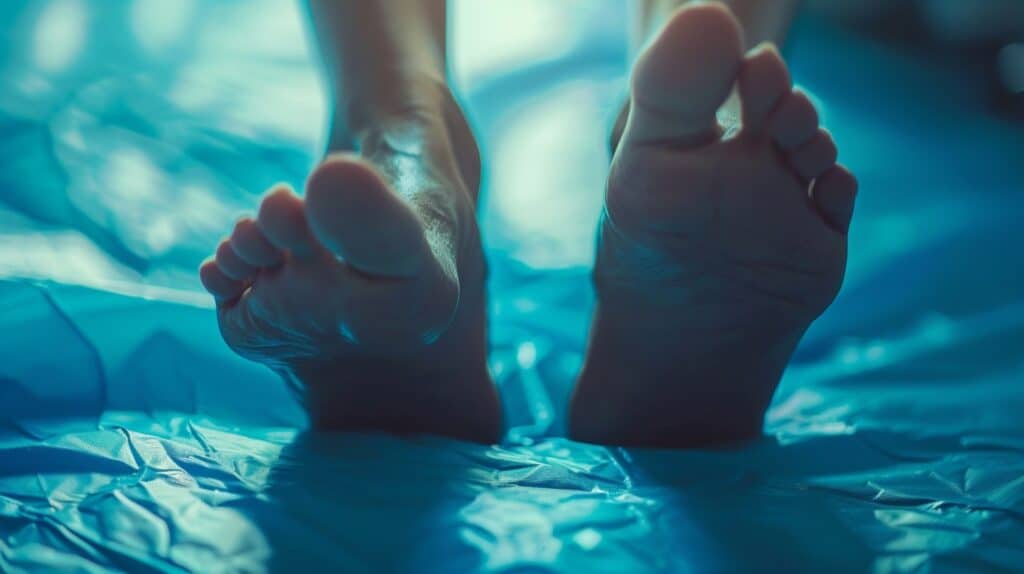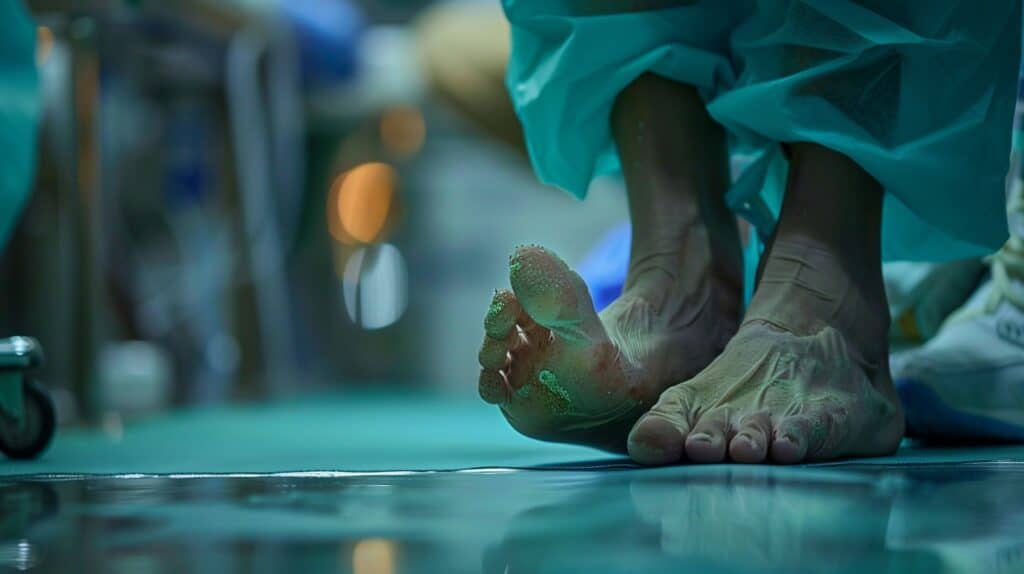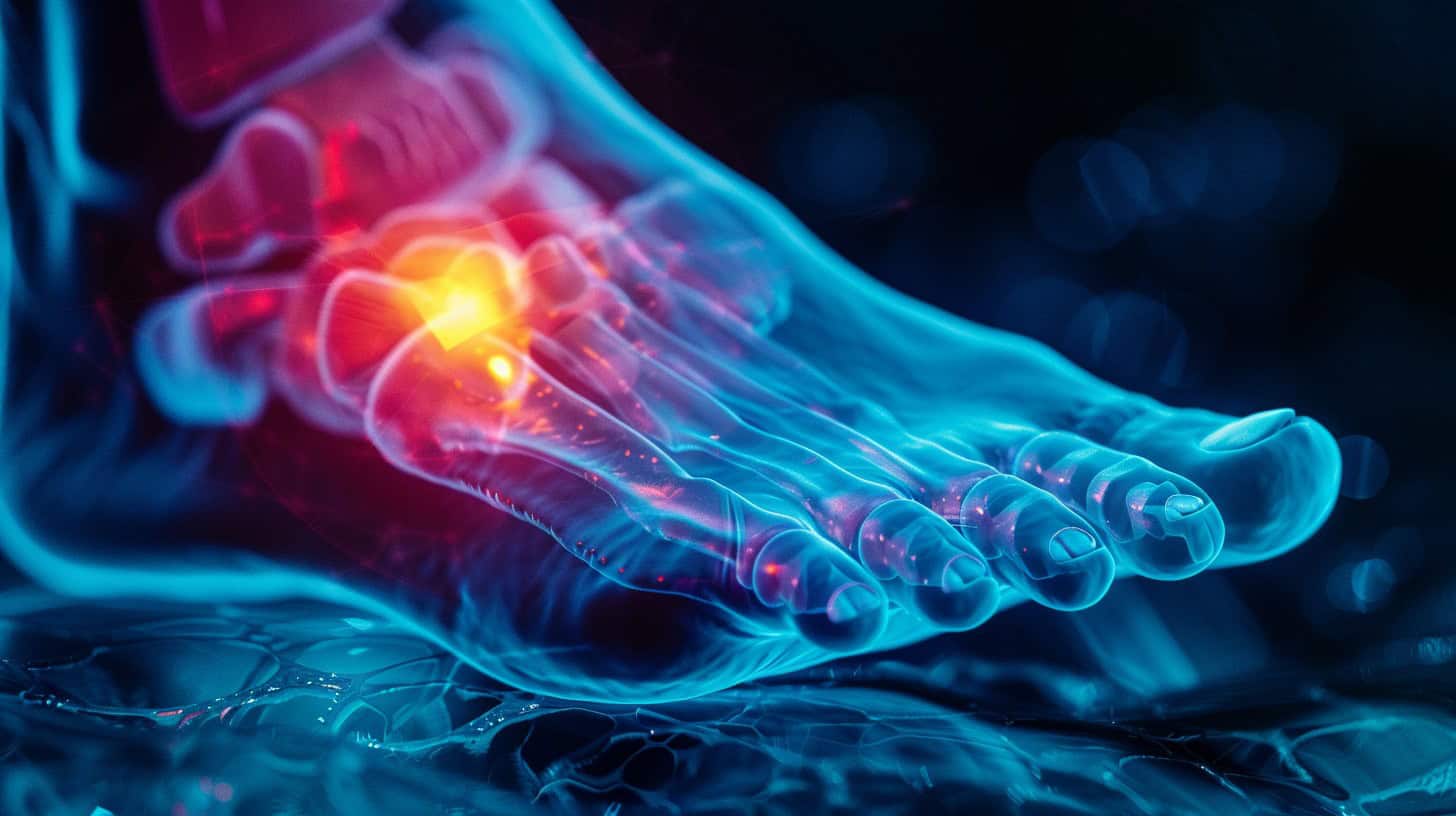Bunions can be a painful nuisance, affecting almost one-third of Americans. This common issue, known as hallux valgus, is a bump on the side of the foot at the big toe joint. It’s often caused by wearing tight-fitting shoes or high heels, and can also result from inherited conditions or rheumatoid arthritis. 1 While bunions won’t disappear on their own, there are several effective ways to manage and reduce the pain.
I’ve been in your shoes—literally—and have found practical steps that work. With my experience using proper footwear modifications, bunion pads and splints, consistent exercises for my toes, ice therapy, and soothing foot soaks and massages…
I’ve seen real improvements without surgery. 3 Ready to learn how? Your feet will thank you!
Key Takeaways
Proper Footwear Choices: Selecting shoes with wide toe boxes and firm yet cushioned soles can reduce bunion pain. Brands like New Balance, Nike, Birkenstock, Naturalizer, and Sole Bliss offer good options. Avoid high heels and narrow shoes for better support.
Bunion Pads and Splints: Using over-the-counter bunion pads cushions the affected area, while splints temporarily straighten the big toe to reduce pain. Toe separators help alleviate pressure during daily activities.
Consistent Toe Exercises: Regularly performing exercises like toe curls, marble pick-ups, and ball rolls strengthens foot muscles and improves flexibility. These exercises help maintain alignment and ease discomfort.
Ice and Heat Therapy: Applying ice packs for 10–15 minutes several times a day reduces swelling around the bunion. Warm foot soaks improve blood flow, relax muscles, and provide significant relief from soreness.
Foot Soaks and Massages: Epsom salt foot soaks decrease inflammation, while massages enhance circulation in the feet. Both methods relieve pain effectively when done regularly.
Table of Contents
The Basics of Bunions

Bunions are bony bumps that form on the joint at the base of your big toe. These can cause pain and swelling, making it hard to walk.
What Leads to Bunions?
Tight-fitting shoes, especially women’s shoes with a narrow toe box, often cause bunions. 2 Inherited conditions play a big role too. If your parents had bunions, you might get them.
Conditions like rheumatoid arthritis can also lead to bunions by causing inflammation in the joints.
Excessive foot pronation and hypermobility of the first ray are other factors. 1 Nearly one-third of Americans deal with these painful bony growths on their big toes. Wearing sandals or sneakers that provide good arch support may help prevent these issues from worsening.
Prevention starts with proper footwear, says Dr. Smith, a top podiatrist.
Is Reversing Bunions Possible?
Bunions cannot be reversed or go away on their own. Surgery, known as a bunionectomy, is the only permanent solution to remove them. A Minimally invasive bunion surgeon can perform this procedure with fewer complications and shorter recovery times. 1
Non-surgical treatments like orthotics and moleskin pads manage pain but do not eliminate the bunion. Applying ice or heat therapy helps reduce inflammation and soreness. 3 Toe exercises also aid in maintaining alignment and easing pain—though these methods won’t make the bunion disappear entirely.
My Journey to Cure My Bunion

I started wearing better shoes with roomy toe boxes. I used bunion pads and did daily toe exercises to help my foot feel better.
Selecting the Right Footwear and Modifications
Choosing the right footwear helps reduce bunion pain and improve foot health. These steps will guide you in selecting shoes and making modifications:
- Pick the Right Shoes:
- Avoid high heels and narrow shoes.
- Choose brands like New Balance, Nike, Birkenstock, Naturalizer, and Sole Bliss.
- Look for shoes with a wide toe box to give your toes room. 1
- Check the Sole:
- Opt for firm yet cushioned soles.
- Ensure the sole supports your foot arch correctly.
- Go for No Heels or Low Heels:
- Select shoes with no heel or very low heel for better support.
- Use Custom Orthotics:
- Obtain custom orthotics at drug stores or specialty shoe stores. 4
- They provide support, balance, and bunion relief.
- Modify Existing Shoes:
- Use bunion pads to cushion the affected area.
- Insert insoles to help with toe alignment.
First-Hand Tips:
- I found New Balance sneakers very comfortable—no pain after wearing them all day.
- Custom orthotics gave my arches great support—they made walking easier.
- Wide toe boxes prevented my second toe from cramping—they allowed more wiggle room.
These simple choices can lead to significant pain relief and better foot health.
Using Bunion Pads and Splints
Switching to the right footwear helped my bunion. 5 Next, I used bunion pads and splints to relieve pain.
- Bunion Pads: These soft pads cushion the bunion. They reduce friction between your shoe and your foot. You can buy them over-the-counter.
- Bunion Splints: These devices temporarily straighten your big toe and aim to realign it. Wearing a splint at night helps. It reduces pain by keeping the toe in a better position.
- Toe Separators: Toe separators can help with spacing the toes properly. This alleviates pressure on the bunion area during daily activities.
- Custom Orthotics: Custom orthotics fit your foot structure precisely and provide needed support. Your podiatrist can help decide if you need these.
- Arch Supports: Over-the-counter arch supports offer additional relief if custom orthotics are not necessary.
- Toe Straighteners: Using these devices regularly aligns the toes and relieves discomfort caused by misalignment. 6
- Regular Use: Consistent use of these items maximizes their benefits, reducing pain over time and improving foot alignment.
These steps worked for me, offering noticeable relief from bunion discomfort.
Consistent Toe Exercises and Stretches
Consistent toe exercises and stretches can help cure bunions. They also reduce pain and increase foot strength.
- Toe Curls: Start with sitting on a chair. Place a towel on the floor under your foot. Use your toes to grasp the towel, then release. Repeat 10 times per foot.
- Marble Pick-Ups: Scatter 20 marbles on the floor. Use your toes to pick them up one by one and place them in a bowl. This helps improve dexterity.
- Toe Points and Curls: Sit comfortably. Stretch out your leg and point your toes forward as far as possible for 5 seconds. Then curl them back for another 5 seconds. Do this 10 times on each foot. 8
- Toe Grabs: Standing, grab the floor with your toes as if trying to pick things up without lifting the heel, hold for 5 seconds, repeat 15 times per foot.
- Ball Rolls: Place a small ball under your arch while seated or standing. Roll it from toe to heel for about two minutes per foot. 7
Maintaining these exercises builds strength and improves recovery. Toe stretching reduces pressure on the MTP joint, crucial in preventing bunions’ progression.
Applying Ice and Heat Therapy
Toe exercises kept my feet flexible, but ice and heat therapy reduced pain. Ice packs decreased swelling. Use them for 10–15 minutes several times a day to numb the area. 10 Swelling goes down faster this way.
Warm foot soaks improved blood flow around my bunion. Soak in warm water for 10–15 minutes daily… This relaxes muscles and eases discomfort too. 9 Heat therapy can help improve circulation, reducing stiffness around the big toe joint.
Ice controls inflammation; warmth aids recovery.
Both methods together kept my pain under control and functional movements easier.
Benefits of Foot Soaks and Massages
Foot soaks with Epsom salts reduce soreness and inflammation. 11 Warm water provides relief from bunion pain by soothing the area. These soaks boost blood flow, easing discomfort in your feet.
Massages also improve circulation and ease soreness. Using massage oil can further reduce inflammation. 12 Regular foot massages can enhance recovery from bunions while relaxing muscles.
Seeking professional advice is crucial if home remedies don’t work.
Seeking Professional Advice

When your bunion pain doesn’t go away, it’s time to see a podiatrist. Custom orthotics can help make shoes more comfortable and align your foot better.
When to See a Podiatrist
Pain that limits mobility or daily activities can signal the need to see a podiatrist. Persistent pain, visible foot structure changes, redness, and swelling around the bunion area are signs to watch for.
Early intervention prevents worsening. 13Severe cases of bunions often require professional help. Podiatrists offer tailored treatment plans based on full knowledge and surgical skills. Custom orthotics can provide relief when natural remedies fail. 6
The Importance of Custom Orthotics
Custom orthotics can cut your hallux valgus angle (HVA). 14 They help with mild to moderate HV. Orthotic Type 1 works best for moderate issues and offers strong support and balance.
Custom-made inserts can avoid bunion surgery by restoring foot function. 15
These orthotics fit perfectly into your shoes, giving comfort while you walk or run. Prescription ones are necessary if you have big foot structure problems like hammertoe or osteoarthritis.
These custom solutions reduce pain and provide greater relief than over-the-counter insoles.
People Also Ask
What are some effective pain relievers for bunions?
Pain relievers like Advil, Aleve, and aspirin can help manage bunion pain. Nonsteroidal anti-inflammatory drugs (NSAIDs) such as ibuprofen or naproxen also reduce swelling.
How does maintaining a healthy weight help with bunions?
Maintaining a healthy weight reduces pressure on your feet. This helps lessen the stress on your bunion, making it less painful.
Can physical therapy cure my bunion?
Physical therapy includes resistance exercises that strengthen foot muscles. Massaging and specific chiropractic techniques can also ease discomfort from hallux rigidus and tailor’s bunions.
Is surgery always needed to fix a bunion?
Surgery is not always needed, but may be recommended by orthopedic surgeons if other treatments fail. Procedures like osteotomy correct severe cases of metatarsalgia caused by bunions.
Are there non-surgical ways to treat calluses and corns from my bunion?
Yes, using compression socks or minimalist shoes can help prevent calluses and corns around the little toe area without needing surgical procedures.
Do custom orthotics work for treating tailor’s bunions?
Custom orthotics provide support tailored to your foot shape, helping alleviate pressure points caused by tailor’s bunions while improving overall foot alignment.
References
- ^ https://www.ncbi.nlm.nih.gov/pmc/articles/PMC2907787/
- ^ https://my.clevelandclinic.org/health/diseases/14386-bunions-hallux-valgus
- ^ https://gaithappens.com/can-bunions-be-treated-and-reversed-effective-solutions-for-foot-pain/
- ^ https://www.pmcfootandankleclinic.com/blog/3-shoe-modifications-that-will-help-your-bunions
- ^ https://www.healthpartners.com/blog/bunion-treatment-without-surgery/
- ^ https://www.nbcnews.com/select/shopping/best-bunion-treatment-at-home-rcna147011
- ^ https://www.verywellhealth.com/exercises-for-bunions-7571141
- ^ https://www.healthline.com/health/bunion-exercises
- ^ https://www.modernfootankle.com/resources/foot-care/guides/bunion-treatment-at-home (2024-02-15)
- ^ https://endeavorct.com/effective-strategies-for-bunion-pain-relief-and-bunion-removal-surgery/ (2024-02-20)
- ^ https://us.solebliss.com/blogs/news/10-best-ways-to-treat-bunions-without-surgery (2022-07-20)
- ^ https://melecafootandankle.com/2024/05/when-should-i-see-a-podiatrist-for-my-bunions/
- ^ https://www.ncbi.nlm.nih.gov/pmc/articles/PMC9564465/
- ^ https://www.newcanaanpodiatry.com/blog/how-custom-orthotics-can-stop-your-bunion-from-growing




